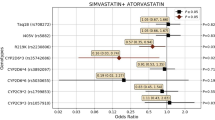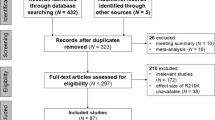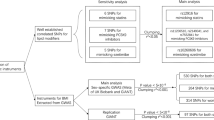Abstract
We investigated the effect of single-nucleotide polymorphisms in sterol regulatory element-binding factors-1a and -2 (SREBF-1a and SREBF-2) and SREBF cleavage-activating protein (SCAP) genes on lipid-lowering response to simvastatin. In all, 146 hypercholesterolemic patients of European descent were prospectively treated with simvastatin 20 mg/day for over 6 months. Of these 99 subjects completed the 6-month follow-up. Plasma lipids and lipoproteins were measured before and throughout the study. The mean percentage decrease in plasma total cholesterol (TC) was greater in subject carriers of SCAP 2386G allele compared with those homozygous for 2386A allele (−29.6±13.4 vs −22.1±13.8%, P=0.007). About 61% of the 2386G carriers were above-average responders for TC levels (ΔTC −27.8%), whereas only 29% of 2386A homozygous reached this reduction (P=0.009). Our data suggest that the SCAP 2386A>G gene polymorphism was a significant predictor of TC and triglyceride responses to simvastatin treatment.
This is a preview of subscription content, access via your institution
Access options
Subscribe to this journal
Receive 6 print issues and online access
$259.00 per year
only $43.17 per issue
Buy this article
- Purchase on Springer Link
- Instant access to full article PDF
Prices may be subject to local taxes which are calculated during checkout

Similar content being viewed by others
Abbreviations
- Apo:
-
apolipoprotein
- CHD:
-
coronary heart disease
- ER:
-
endoplasmatic reticulum
- HDL-C:
-
high-density lipoprotein cholesterol
- LDL-C:
-
low-density lipoprotein cholesterol
- SCAP:
-
SREBF cleavage-activating protein
- SD:
-
standard deviation
- SNPs:
-
single-nucleotide polymorphisms
- SREBF:
-
sterol regulatory element-binding factor
- TC:
-
total cholesterol
- TG:
-
triglyceride
- WD:
-
triptophane-aspartate
References
Pignone M, Phillips C, Multow C . Use of lipid lowering drugs for primary prevention of coronary heart disease: meta-analysis of randomised trials. BMJ 2001; 321: 1–5.
Vaughan CJ, Gotto AM, Basson CT . The evolving role of statins in management of atherosclerosis. J Am Coll Cardiol 2000; 35: 1–10.
Gotto AM . Emerging perspectives on lipid management: international approaches and global challenges. Am J Cardiol 2001; 88: 876–881.
Maitland-van der Zee AH, Klungel OH, Stricker BHC, Verschuren WMM, Kastelein JJP, Leufkens HGM et al. Genetic polymorphisms: importance for response to HMG-CoA reductase inhibitors. Atherosclerosis 2002; 163: 213–222.
Hoffman MM, Winkelmann BR, Wieland H, Marz W . The significance of genetic polymorphisms in modulating the response to lipid-lowering drugs. Pharmacogenomics 2001; 2: 1–11.
Eberle D, Hegarty B, Bossard P, Ferre P, Foufelle F . SREBP transcription factors: master regulators of lipid homeostasis. Biochimie 2004; 86: 839–848.
Brown MS, Goldstein JL . A proteolytic pathway that controls the cholesterol content of membranes, cells, and blood. Proc Natl Acad Sci USA 1999; 96: 11041–11048.
Edwards PA, Tabor D, Kast HR, Venkasteswaran A . Regulation of gene expression by SREBP and SCAP. Biochim Biophys Acta 2000; 1529: 103–113.
Gimpl G, Burger K, Fahrenholz F . A closer look at the cholesterol sensor. Trends Biochem Sci 2002; 27: 596–599.
Horton JD, Goldstein JL, Brown MS . SREBPs: activators of the complete program of cholesterol and fatty acid synthesis in the liver. J Clin Invest 2002; 109: 1125–1131.
Nakajima T, Hamakubo T, Kodama T, Inazawa J, Emi M . Genomic structure and chromosomal mapping of the human sterol regulatory element binding protein (SREBP) cleavage-activating protein (SCAP) gene. J Hum Genet 1999; 44: 402–407.
Hua X, Nohturfft A, Goldstein JL, Brown MS . Sterol resistance in CHO cells traced to point mutation in SREBP cleavage-activating protein. Cell 1996; 10: 1096–1107.
Salek L, Lutucuta S, Ballantyne CM, Gotto Jr AM, Marian AJ . Effects of SREBF-1a and SCAP polymorphisms on plasma levels of lipids, severity, progression and regression of coronary atherosclerosis and response to therapy with fluvastatin. J Mol Med 2002; 80: 737–744.
Fan YM, Laaksonen R, Janatuinen T, Vesalainen R, Nuutila P, Knuuti J et al. Effects of pravastatin therapy on serum lipids and coronary reactivity are not associated with SREBP cleavage-activating protein polymorphism in healthy young men. Clin Genet 2001; 60: 319–321.
Beiard SL . HMG-Coa reductase inhibitors: assessing differences in drug interactions and safety profiles. Am J Pharm Assoc 2000; 40: 637–644.
Chong PH, Seeger JD, Franklin C . Cinically relevant differences between the statins: implications for therapeutic selection. Am J Med 2001; 111: 390–400.
Igel M, Sudhop T, vonBergmann K . Metabolism and drug interaction of 3-hydroxy-3-methylglutaryl coenzyme A-reductase inhibitors (statins). Eur J Clin Pharmacol 2001; 57: 357–367.
Parra FC, Amado RC, Lambertucci JR, Rocha J, Antunes CM, Pena SD . Color and genomic ancestry in Brazilians. Proc Natl Acad Sci USA 2003; 100: 177–182.
Zembrzusky VM, Callegari-Jacques SM, Hutz MH . Utilização de marcadores autossomicos para o controle de estratificação populacional em estudos de associação. Anais do 50° Congresso Brasileiro de Genética 2004. Florianopolis: Brazil, p 503.
Shimano H . Sterol regulatory element-binding proteins (SREBPs): transcriptional regulators of lipid synthetic genes. Prog Lipid Res 2001; 40: 439–452.
Yang WS, Deeb SS . Sp1 and Sp3 transactivate the human lipoprotein lipase gene promoter through binding to a CT element: synergy with the sterol regulatory element binding protein and reduced transactivation of a naturally occurring promoter variant. J Lipid Res 1998; 39: 2054–2064.
Botma GJ, van Deursen D, Vieira D, van Hoek M, Jansen H, Verhoeven AJM . Sterol-regulatory-element binding protein inhibits upstream stimulatory factor-stimulated hepatic lipase gene expression. Atherosclerosis 2005; 179: 61–67.
Salzano FM, Freire-Maia N . Problems in Human Biology. A Study of Brazilian Populations. Wayne State University Press: Detroit, 1970.
Friedewald NT, Levy RI, Fredrickson DS . Estimation of the concentration of low-density lipoprotein cholesterol in plasma, without using the preparative ultracentrifuge. Clin Chem 1972; 18: 499–502.
Lahiri DK, Nurnberger JI . A rapid non-enzymatic method for the preparation of HMW DNA from blood for RFLP studies. Nucleic Acid Res 1991; 19: 5444.
Iwaki K, Nakajima T, Ota N, Emi M . A common Ile796Val polymorphism of the human SREBP cleavage-activating protein (SCAP) gene. J Hum Genet 1999; 44: 421–422.
Védie B, Jeunemaitre X, Mégnien JL, Atger V, Simon A, Moatti N . A new DNA polymorphism in the 5′ untranslated region of the human SREBP-1a is related to development of atherosclerosis in high cardiovascular risk population. Atherosclerosis 2001; 154: 589–597.
Miserez AR, Muller PY, Barella L, Barella S, Staehelin B, Leitersdorf E et al. Sterol-regulatory element-binding protein (SREBP-2) contributes to polygenic hypercholesterolemia. Atherosclerosis 2002; 164: 15–26.
Dupont WD, Plummer WD . PS power and sample size program available for free on the Internet. Control Clin Trials 1997; 18: 274.
Acknowledgements
We thank the staff of Centro de Diagnóstico Cardiológico for their assistance. Financial support for this work was provided by Conselho Nacional de Desenvolvimento Científico e Tecnológico (CNPq, Brazil), Programa de Apoio a Núcleos de Excelência (PRONEX, Brazil) and Fundação de Amparo à Pesquisa do Estado do Rio Grande do Sul (FAPERGS, Brazil). We are also grateful to the Merck Sharp & Dohme Pharmaceutical Company for providing simvastatin for this project.
Author information
Authors and Affiliations
Corresponding author
Additional information
DUALITY OF INTEREST
None declared.
Rights and permissions
About this article
Cite this article
Fiegenbaum, M., Silveira, F., Van der Sand, C. et al. Determinants of variable response to simvastatin treatment: the role of common variants of SCAP, SREBF-1a and SREBF-2 genes. Pharmacogenomics J 5, 359–364 (2005). https://doi.org/10.1038/sj.tpj.6500334
Received:
Revised:
Accepted:
Published:
Issue Date:
DOI: https://doi.org/10.1038/sj.tpj.6500334
Keywords
This article is cited by
-
Pharmacogenomics of statins: lipid response and other outcomes in Brazilian cohorts
Pharmacological Reports (2022)
-
ESR1 polymorphisms and statin therapy: a sex-specific approach
The Pharmacogenomics Journal (2016)
-
Influence of SREBP-2 and SCAP Gene Polymorphisms on Lipid-Lowering Response to Atorvastatin in a Cohort of Chilean Subjects with Amerindian Background
Molecular Diagnosis & Therapy (2014)
-
SCAP gene polymorphisms decrease the risk of nonalcoholic fatty liver disease in females with metabolic syndrome
Journal of Genetics (2013)
-
Pharmacogenetics of response to statins
Current Atherosclerosis Reports (2007)



